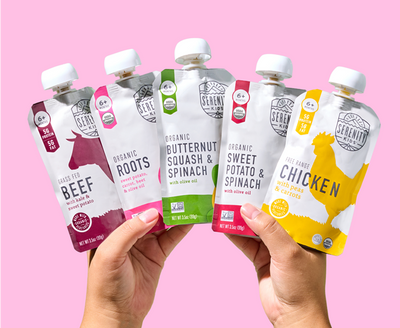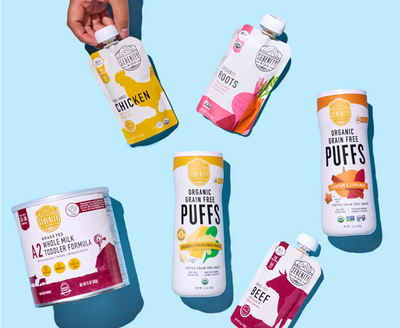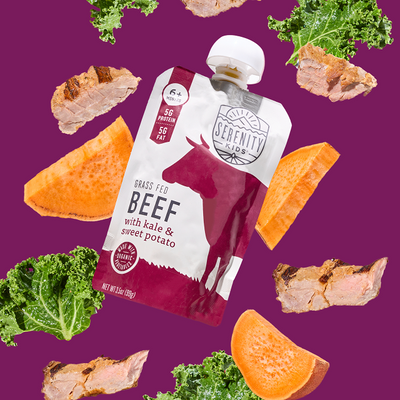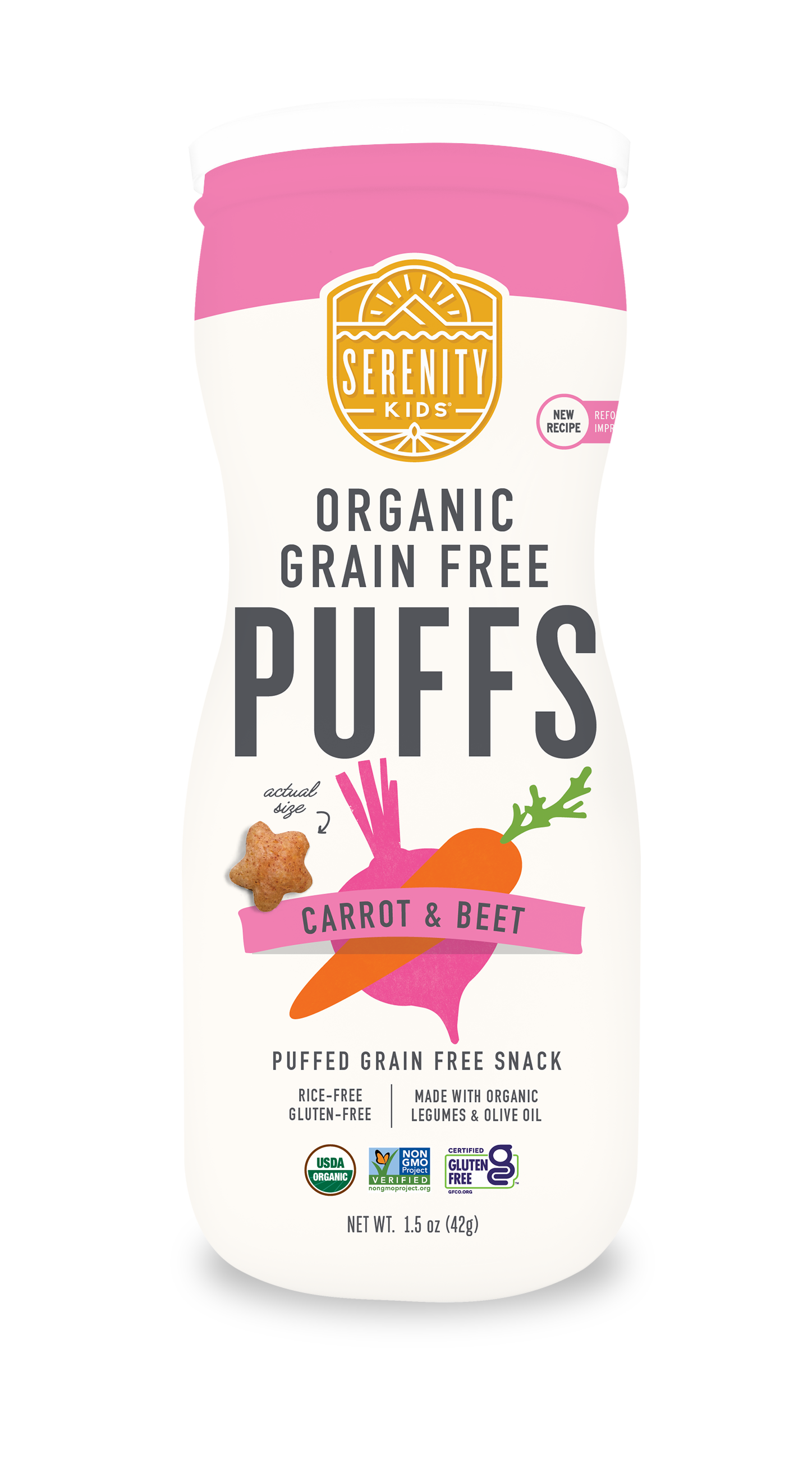Starting babies on solids can be an exciting and messy journey! Their first year is full of so many new adventures and surprises; adding food into the mix can be a daunting and overwhelming task.
There’s a whole world of flavors out there to discover - spinach, turkey, sweet potatoes, oh my! Learning when to give a baby baby food can help set them on a path to developing healthy eating habits, expanding their palate, helping them stay strong, and fostering a positive relationship with food.
This baby solid food guide will go over all five signs to look for when starting babies on solid food, how to introduce those foods, and a guide featuring the top 10 best meats and veggies to start with.
When do babies start eating solid foods?
Traditional baby food or baby purees didn’t hit the market and become a popular option until the 1920s when Harold Clapp invented them to help feed his six-month-old child. When his wife had fallen ill and was unable to care for their infant, Clapp started making soups for his child to eat and realized there was a big gap in the market.
Before then, babies actually didn’t start eating solids until almost a year old.
The invention of baby food drastically changed the age when parents started to give their babies solid food and even dipped as low as six weeks in the 1950s, far before they were mentally or physically ready to handle anything more than breastmilk or formula.
Modern research has shown that a baby is ready for solid food when they demonstrate five main signs of readiness:
- They can hold their head up unassisted
- They reach for and are interested in YOUR food
- They have at least doubled their birth weight
- Their tongue-thrust reflex is gone
- They aren’t battling any recurring illnesses
We will break down these five signs so we can figure out together when our can babies can join in meals with us. But the bottom line: don’t rush it!
Don’t Rush It
It’s so exciting to introduce new things to our babies, especially for those of us that love food so much! And there is a lot of research that is showing the harm that can come from feeding babies, even very tiny amounts like “tastes”, of solid food before they’re ready. The saying “food before one is just for fun” is an important guideline, reminding us that there’s no reason to rush a baby into solid food, breastmilk can provide all the nutrition they need well past 6 months old. So take it slow.
When Can I Give My Baby Solid Food?
When They Can Hold Their Head Up Unassisted
This is one of the most important factors when determining when a baby is ready to eat solid food. If a baby cannot hold their head up unassisted, they may not be able to chew and swallow their food properly, and are put at a greater risk of choking. This is also the same for sitting up unassisted. If babies can sit in a highchair, they will likely be positioned well for food swallowing and digestion.
They Reach for and Are Interested in Your Food
A key sign that your baby is ready to try foods is when they start showing a big interest in what you are eating. Babies around six months old might start staring at us while we eat or even reaching for our food. This shows that they’re mentally ready to try new foods, and the ability to grasp at items and hold them in their cute little hands shows they are also physically ready.
They Have at Least Doubled Their Birth Weight
According to the American Academy of Pediatrics, babies might be ready to begin trying solid foods once they weigh at least 13 pounds and have doubled their birth weight, which usually happens around six months of age.
Their Tongue-Thrust Reflex Is Gone
Another significant milestone to wait for before giving an infant baby food is the loss of their tongue-thrust reflex. If your baby is unable to push purees or food to the back of their mouth to swallow it, their tongue-thrust reflex might not be gone. This reflex usually starts to disappear around four months old, but the best way to test it is to place a tiny bit of food thinned with milk in your baby’s mouth. If the baby's mouth opens and accepts the food, without thrusting their tongue forward, then their reflex is fading or already gone.
They Aren’t Battling Any Recurring Illnesses
Our babies’ bodies do so much when they are sick, so introducing new foods and new things to their routine when they are busy fighting off sickness is not ideal. In addition, symptoms from an illness, whether acute or chronic, may be misinterpreted as adverse reactions to food. Give a baby time to recover from any illness before introducing something new.
Tips for Introducing Solid Foods to Baby
Now that we know the top five signs of when babies should eat real food, we can start on properly introducing them to their new adventures in eating.
One of the first steps in raising a good eater is to show them how fun and yummy new foods can be. Babies who see their caregivers eating healthy food and enjoying it are far more likely to be interested in following their example. After all, we all know babies are little sponges who love to follow our lead.
Here are a few more tips to ensure baby becomes a healthy, successful eater:
- Don’t rush: The first feedings are never fast when it comes to babies, and it might be surprising how long it takes to get that pureed goodness down the hatch! You might even end up with more on their bibs than in their stomachs. Give yourself and your baby plenty of time for feedings and plenty of practice. Check out this article on the dos and don’ts for introducing solids in a safe and stress-free way. There is no timeline or race when it comes to giving babies their first solids. The "perfect" time when babies can eat real food is whenever both the caregiver and baby are ready. And when you do start, don’t be in a hurry to finish that race either. Trying new food can be exciting, daunting, or even a little scary for some babies. So being patient and going slow is key to creating healthy eaters.
- Introduce a high chair and silverware first: Babies are so curious about new routines, textures, toys, and everything in between. Because of this, it is recommended to have them be familiarized with the utensils and tools they will be using before it’s time to start. Have them sit in the high chair during your meals, and let them play with their future spoons to learn how to hold them properly. Once they’ve become more familiarized with these tools, food is the next step.
- Don’t worry about portions: Down the road, we may focus more on feeding our baby the right amount of macronutrients, fats, and minerals (P.S. do you know the truth about heavy metals in some baby food brands?), but for now, our focus should be on enjoying the new experiences we’re all going through - together, and trusting that your little one inherently knows how to respond to his or her hunger and fullness cues.
Gagging vs. Choking: What is the Difference?
Trying new foods may come with a good amount of gagging. After all, babies need to work on their gag reflex to ensure they can properly swallow all different kinds of foods. But that doesn’t mean it’s any easier or less scary for us!
Alarming as it might seem, it is perfectly normal for a baby to gag during their first encounter with any kind of food. Knowing the difference between when to intervene and when to allow them to help themselves can be difficult.
- Choking: A child who is choking will often have wide eyes and will not be making any sounds. Choking is silent.
- Gagging: A baby who is experiencing a gag reflex will be coughing and making sounds. Gagging is loud.
We encourage caregivers to familiarize themselves with the tools needed to deal with choking. There are a number of great courses and resources online from organizations like the Red Cross.
Baby's First Solid Food List
Now that we know when and how to introduce solid foods to our babies, let’s learn what kind of foods make an excellent first choice!
In no particular order:
- Pureed or Pre-Chewed meat
- Organ Meats
- Bone Broth
- Egg Yolk
- Sweet potato
- Bone marrow
- Pureed salmon
- Cooked and pureed broccoli
- Avocado
- Cooked green beans
- Squash
If Baby doesn’t like a food at first, that’s ok; keep offering. Sometimes it takes a dozen or more introductions to something before they are willing to accept it.
Our Ultimate Baby Solid Food Guide
Starting solid foods can be an exciting and thrilling new adventure. It is a lot of fun to watch your little one experience the same tastes and textures that you have come to love yourself.
We hope you are excited and ready to start introducing some yummy firsts to your beautiful babies. Although we know it can feel daunting transitioning your baby to solid foods, we hope with this baby solid food guide, you’ll feel confident you’re doing it safely.
Remember these essential tips:
- Take your time and don’t rush - no need to be in a hurry.
- Gagging is normal and perfectly ok. Learn the difference between gagging and choking, and educate yourself on how to handle choking.
- Show them how fun new foods are! Babies naturally model after their caregivers.
- Focus more on the experience of eating, not on what they actually consume.
Your new adventures in baby food will be so thrilling and exciting! If you decide when you can give your little one baby food, and you use Serenity Kids pouches or puffs, please make sure to give us a tag on social media so we can see all the fun you’re having; we love to see kiddos enjoying our products.
Looking for more on this topic? Check out this article—Introducing Solids: Why We Love Both Baby-Led Weaning and Purees.
Free Baby Nutrition eBook
Check out our free, revolutionary ebook by Dr. Sarah Ballantyne (The Paleo Mom) and Serenity Kids co-founder Serenity Carr. Get the most up-to-date information on what and how to feed weaning babies. Learn the essential nutrients needed for a baby's growth, macronutrient ratios, how to make a balanced meal, and more.
What other parents are reading right now:
As with any new recipe or flavor introduction to your little one, consult with a healthcare professional. All content within this site is not intended as medical diagnosis or treatment and should not be considered a substitute for, nor does it replace professional medical advice, diagnosis, or treatment. If you have any concerns or questions, you should always consult with a physician or other healthcare professional.
Written by Kellyann Doyle. Kellyann is a contributing writer for Serenity Kids and a freelance copywriter. She earned her Bachelor's Degree in 2013 from the University of Houston with a Major in Communications and a Minor in Marketing. When she isn't chasing her 8 months old daughter around, you can find her trying new recipes, enjoying a good nap, or re-watching Friends for the 500th time.

















































